|
|
| |
| |
 |
DARLINGe Progress
|
|
The DARLINGe project (DANUBE REGION LEADING GEOTHERMAL ENERGY) has reached now 1.5 years and the state-of-art analyses (WP5) made in the project area was completed. The respective reports of the following themes can be downloaded from the project web site from the Library section.
|
|
|
| |
 |
Reservoir characterisation
|
| |
 |
| |
|
Geothermal potential map of the basement reservoirs – comparisons between modelled and measured temperatures
|
|
|
Estimation of the geothermal energy resources was carried out for 11 sub-regions by applying a probabilistic method, which is based on the variable simulation of reservoir parameters, such as effective porosity, depth, clay content and temperature, and also considered the recovery factor. The developed novel methodology provides basis for the transboundary and supra-regional thermal energy management on the south-eastern part of the Pannonian Basin and can serve as an example for other regions.
 |
| |
|
Regions of resources estimation
|
|
| |
 |
Current status of geothermal water uses
|
| |
The final overview of current utilization identified 767 geothermal wells on the project area at the end. The large number of collected information made possible various analyses and their visualization on different diagrams and maps that provide an easy-to-understand overview. The key findings are the following:
- Thermal water temperature exceeds 50°C at 51% wells, while the highest measured temperature reached 101°C in Hungary. This confirms a very favourable potential for geothermal heat production.
- The average well depth is approximately 1145 m.
- About 13% of wells are younger than 10 years, additional 17% below 30 years, while 26% are older than 50 years.
- Bathing and balneological use is prevalent with 24%, but only 15% of these also have heating systems applied. Different types of heating with 16% successfully follow, out of these 13 wells produce water for district heating and 3 for individual space heating. Additional 9% have agricultural use, dominantly (greenhouse) heating. Mostly in Hungary, drinking water (17%), industrial use (5%) and monitoring wells (2%) are also common. About 5% of objects are reinjection wells.
- Only 62% objects have had production information provided which summed to (at least) 40·106 m3 per year, wherefrom 85% was exploited from basin fill and Pannonian reservoirs.
- In total, 72% of objects have had granted water rights, 6% mining rights, 2% geothermal rights, 1% no rights, and the others no information on permits.
 |
| |
|
Distribution of average outflow temperatures of thermal waters of the wells studied in the project area
|
|
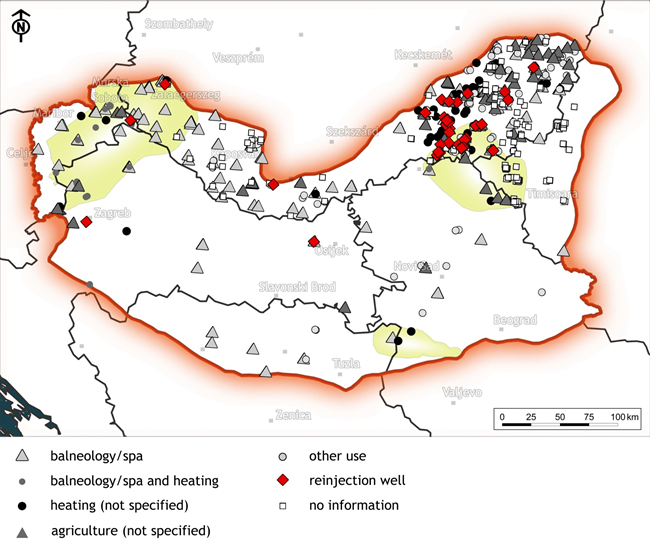 |
| |
|
Types of thermal water utilization in the project area
|
|
| |
 |
Heat market analysis
|
| |
A detailed analysis of heat sector and heat market analyses was carried out in all 6 partner countries at 3 levels: (1) national overview of energy strategies with a focus on the heating sector and renewables, (2) assessment of the heating sector and main heat consumers and habits at regional level, (3) detailed analysis at local scale (typically at municipality or user levels).
It was concluded that all partner countries have some similarities in their geographical, geological, economic and social parameters. The project area is sparsely populated compared to the western regions of Europe, and its economy as well as its infrastructure is underdeveloped. It was concluded that the settlement infrastructure for geothermal district heating development is not favourable: many small rural villages are scattered around and only few large cities exist with sizeable heat market, although the majority of the population is urban (69.2%).These cities are very often supplied by centralized, fossil fuel based district heating services, however obsolete ones which need fundamental renovations to be converted to geothermal based systems. Nevertheless a main conclusion is that these cities with district heating networks located on highly potential reservoirs should be in the forefront of geothermal expansion. In addition, residential heat demand can be successfully supplied by local cascaded systems.
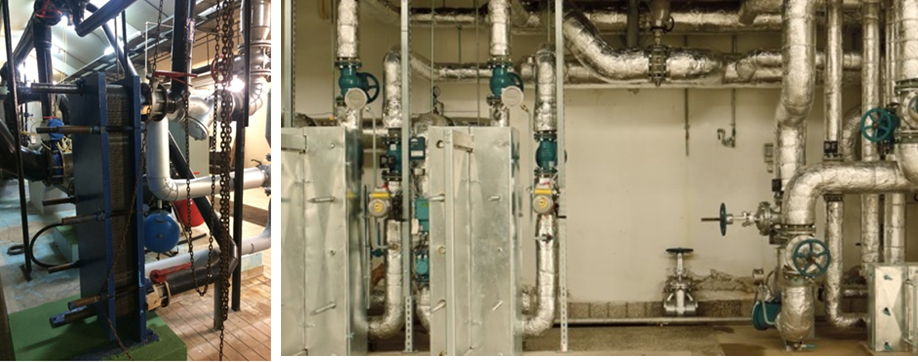 |
| |
|
a) Heat exchanger at the heat center of Mladost cascade system, Croatia. b) Geothermal power plant at Szeged, Ungary
|
|
| |
 |
Regulatory framework
|
| |
The national regulatory framework report analysed the licensing procedures in each of the six partner countries on the basis of flow-charts describing the licensing steps and the answers to a questionnaire which took into account:
- definition of geothermal energy in the national legislation
- ownership and access to geothermal resources
- allowed exploitation (without license)
- role and voice of landowner in licensing
- criteria for granting a license
- duration of licenses and renewal
- terms/contents of licenses
- termination and revision of licenses
- regulatory and information obligations
- heat purchase agreements
- environmental impact assessment (EIA)
- other licenses
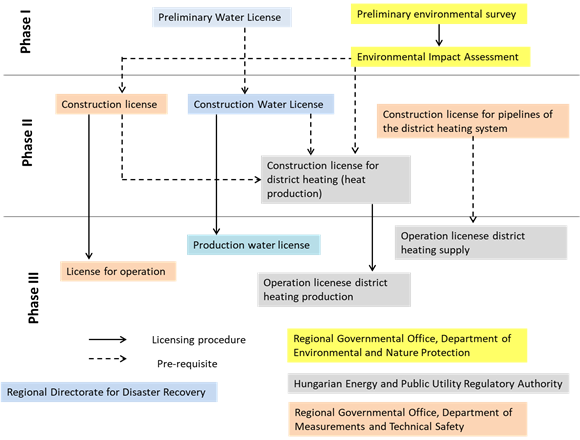 |
| |
|
Licensing procedure for geothermal water in Hungary
|
|
The common and different aspects regarding the licensing procedures were thus identified in the project countries, which will be made available to decision makers and relevant authorities in order to improve and make the regulatory systems more concise and transparent.
| |
 |
Progress on the functionalities of the Danube Region Geothermal Information Platform (DRGIP)
|
| |
During project meetings held in May in Zagreb and Belgrade, project partners agreed on the functionalities of the web-based interactive portal (DRGIP). It was decided to make the platform metadata INSPIRE-compliant, in accordance with the specifications of the INSPIRE Directive that EU Members States should implement at national level.
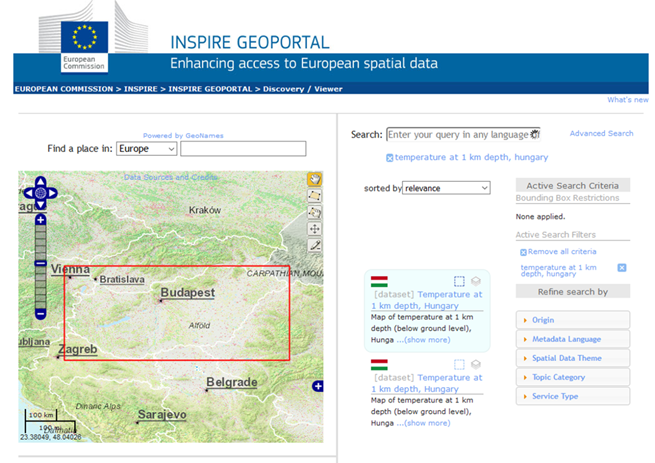 |
| |
|
INSPIRE-compliant proposed DARLINGe services (metadata)
|
|
| |
 |
Transnational Strategy and development of tool-box
|
| |
During the third project period the main streamline of activities focused on the elaboration of the Danube Region Transnational Strategy, for which a major input was an extensive SWOT analysis that identified the inner (Strengths and Weaknesses) and outer (Opportunities and Threats) factors related to: reservoir characterization in project area, current utilization of geothermal water, heat market assessments, regulatory framework and financial mechanisms which support the development of geothermal projects. Each partner prepared its own SWOT for the mentioned fields, viewed from its own perspective (governmental institution, research and development organization, university, local municipality, company etc.), then a summary was made up highlighting the common aspects.
The other main area of actions covered the development of three different methods (comprising a tool-box) that will assist the sustainable management of joint geothermal energy resources shared by the partner countries, and will be tested and verified on the pilot areas in 2018-2019. These methods are the following:
- benchmark evaluation – various indicators are calculated based on input parameters from currently operating thermal water wells which makes possible comparisons between various regions, or countries
- applying the UNFC-2009 (United Nations Framework Classification for Fossil Energy and mineral Reserves and Resources 2009) scheme to several geothermal projects at different stages of development in the project area, that will help to identify how to follow ideal pathways in a project life-cycle
- developing a geological risk mitigation scheme which reduces the risk of unsuccessful drilling, the major factor which hampers the financing of geothermal wells.
The SWOT analyses and tool-box were presented for feedback to the 2nd meeting of the Transnational Stakeholders Forum of the project, organized on 12 June 2018 at City Plaza in Zagreb, Croatia, followed by a field trip to Krapinske Toplice, where further consultations continued in a relaxed atmosphere.
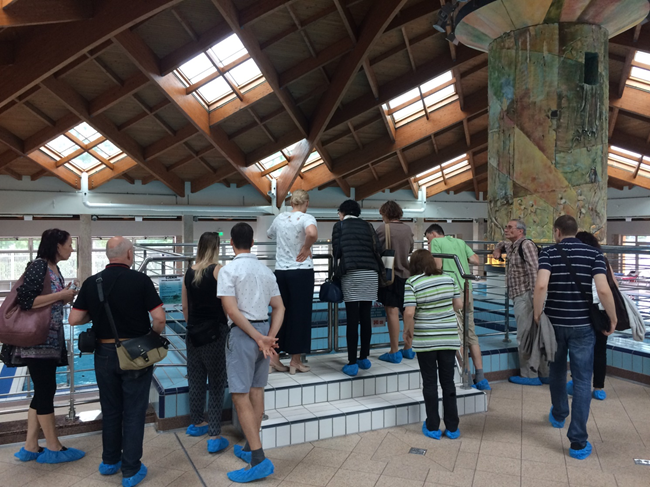 |
| |
|
Field trip to Krapinske Toplice, Croatia
|
|
| |
 |
DARLINGe Presence at International and National Events
|
The project was presented during its third period of activity (January – June 2018) at:
- 5th meeting of the Pomurje Regional Living Lab. 26-27 February, Maribor, Slovenia (two oral presentations);
- Meeting of Young Geoscientists, 6-7 April, Hajdúszoboszló, Hungary (oral presentation);
- The 30th International Fair of Construction, Energetics, Municipal Services and Trade MEGRA and the 4th International Fair of Sustainable Technologies and Green Lifestyle GREEN where there were presented 220 exhibitors from 11 countries on an area of more than 9,000 m2 (booth). The fair was held from 4th to 7th April 2018 in Gornja Radgona and have 8.000 of visitors.
- 16th meeting of the Central European Tectonic Studies Groups, 18-21 April, Rytro, Poland (poster and abstract published in “Geology, Geophysics and Environment”);
- 9th Resource Classification Week of the UNECE-EGRC (United Nations Economic Commission for Europe - Expert Group on Resource Classification) April 23-27, Geneva, Switzerland (oral presentation);
- EUSEW Policy Session “Coupling efficiency and renewables with security of heat supply”, 7 June, Brussels, Belgium (oral presentation).
- In the frame of EU campaign "EU PROJECT, MY PROJECT 2018" on 14th May 2018 in Martjanci an oral presentation was made by the director of LEA Pomurje, Bojan Vogrinčič, together with the presentation of the Local energy agency Pomurje;
- 17th Geological Congress, 17-20 May, Vrnjacka Banja, Serbia (oral presentation).
 |
| |
|
Eva Hoós, Policy Officer from DG Energy gives the key-note lecture at the EUSEW Policy Session “Coupling efficiency and renewables with security of heat supply”
|
|
| |
 |
Future activities
|
| |
In the second semester of 2018 DARLINGe team will focus on pilot activities encompassed with a lot of field work and alive contacts with stakeholders from the pilot areas. Parallel with this, the DRGIP interactive portal development will continue and partners plan to start establishing and testing its various modules as well.
|
| |
 |
Contact
Annamaria Nador (Lead Partner coordinator) – nador.annamaria@mbfsz.gov.hu
DARLINGe website http://dtp.interreg-danube.eu/approved-projects/darlinge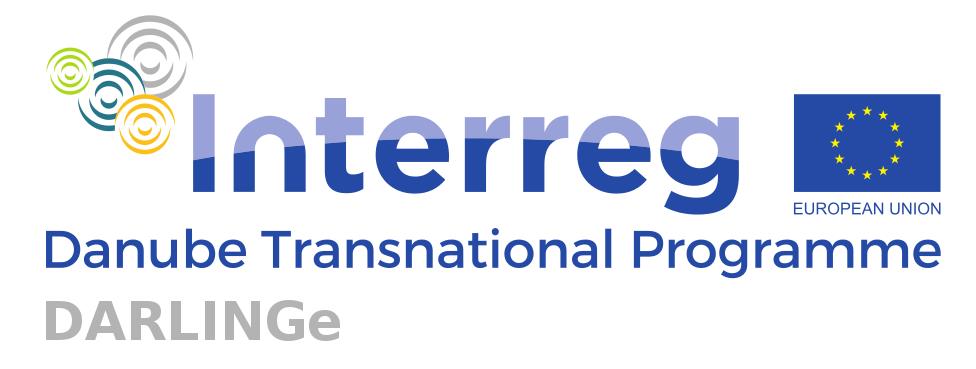
|
| |
|
|
|
|
| |
|
If you have received this newsletter, you have been included on one or more of the Danube Transnational Programme/projects postal mailing lists. We are committed to respect and protect the privacy of personal data collected. We regard your personal data as confidential information and will never communicate it to third parties. Your personal data are used mainly for the express purpose of receiving the newsletter. Your mailing details may also be used by the DTP and its projects for information and dissemination purposes strictly related to the programme and its projects. If you prefer not to receive more of this newsletter and your data not to be used for dissemination purposes, you can unsubscribe by sending a reply email.
|
|
|
|
|
|
